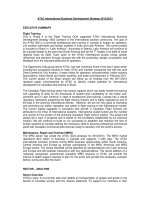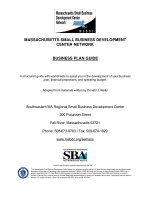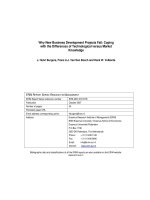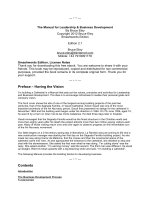Business Development Workshops-1
Bạn đang xem bản rút gọn của tài liệu. Xem và tải ngay bản đầy đủ của tài liệu tại đây (110.32 KB, 17 trang )
Business Development Competition
Student Workshops
Workshop 1
Give a brief overview of the HSHT Business Development Competition. Explain that over the
next few weeks they will begin to create a business plan for an entrepreneurial venture.
Today, the students will test their knowledge about being an informed entrepreneur, and learn
about the six characteristics of successful entrepreneurs.
Myths and Facts Activity
Explain that people who start their own business are entrepreneurs. Explain that entrepreneurs
can start a traditional business or a nonprofit business. Emphasize that nonprofit businesses,
like traditional businesses, must make money to operate; however, their primary concern is
their cause. Those who start these businesses are called social entrepreneurs. Define the
following key terms for the students:
Entrepreneur: a person who creates and organized a new business.
Nonprofit Business: a business that is no run for the purpose of making a profit, but to
increase the well-being of others in certain areas, such as education, religion, health,
and other causes.
Social entrepreneur: a person who starts a business with a social issue as the primary
focus.
Point out that many people develop a great idea for a business but do not succeed because of
misunderstandings about being an entrepreneur. Tell the students they will now check their
own knowledge against several common myths about entrepreneurship.
Designate one side of the classroom as the “Myth” and the other as “Fact”. Ask the students to
stand in the center of the room. Explain that you will read aloud statements about
entrepreneurships. After each statement, they should decide on their response and move to the
corresponding side of the room.
Ask volunteers to explain their reasoning and then provide the correct answer and explanation
noted below in blue text. Add local and personal illustrations, as appropriate.
Entrepreneurs have to be risk takers.
Answer: Myth- There are risks involved in being an entrepreneur; however, there are
risks in any career path. Businesses downsize, close, and hire and fire at will. Trusting in a
high-paying, stable career within a business is also risky.
People are born with traits to be a successful entrepreneur; it’s genetic.
Answer: Myth - Entrepreneurs often have average educations, IQ, and work experience.
There are no traits or criteria that make them unique from the general population.
Small businesses make up 99.7 percent of U.S. employer firms.
Answer: Fact- The Small Business Association reports there were 28.2 million businesses
in the United States in 2011. There were only 17,700 firms with 500 or more employees
in 2011.
Successful entrepreneurs don’t need formal training in a business school.
Answer: Fact- Entrepreneurs need to know their industry, and they need to be able to
run a business. But business school is not a requirement and not what most
entrepreneurs chose. However, entrepreneurs cannot dismiss the education, formal and
informal, that is required by their industry.
Entrepreneurship is about getting rich fast.
Answer: Myth- Entrepreneurs need money to start and maintain a business, but few
ever make the money earned by corporate CEOs. Investors who fund entrepreneurs
expect a return on their investment. However, they watch for and decline to fund getrich-quick, risky ventures.
Learning about entrepreneurship is useless if a person isn’t going to own a business.
Answer: Myth- Even if someone never owns a business, learning entrepreneurial skills
and having an entrepreneurial spirit can be applied to any career to enhance job
performance and quality of life. All the concepts presented in this program can be
applied to employees in any business, and businesses increasingly say they are looking
for innovative workers- just what an entrepreneur is.
Ask the students to return to their seats. Conclude the activity by telling them that
entrepreneurial characteristics can be developed, practices, and improved. Explain that no
matter how good a business idea is, the most important element of a business startup is an
informed entrepreneur. Emphasize that they are their own most valuable asset.
Entrepreneur Inventory
Tell the students that successful entrepreneurs need tools to face the challenges of starting a
business. The characteristics they develop and expect from themselves can be tremendous
assets- and the lack of them can be tremendous liabilities.
Tell the students they will examine some of the characteristics commonly found among
successful entrepreneurs and then complete a self-evaluation of their own traits.
On the board, list the six qualities and skills commonly shared by successful entrepreneurs.
After you read a brief description of each characteristic (noted in blue text), have the students
rate their current performance level. Copy the scale below on the board.
4= I have mastered this characteristic and have no need for further development.
3= This characteristic is a strength of mine but still needs further development.
2= This characteristic is not yet a strength but could be with some development.
1= This characteristic is a weakness and will be a challenge to develop.
Six Characteristics of Successful Entrepreneurs:
Perseverance
Entrepreneurs face many challenges- from day-to-day decisions to problems with suppliers,
customers, and production. These challenges must be addressed with determination and
commitment to the venture. Without perseverance, a business owner may ignore or try to
sidestep problems, leading to negative consequences and potential failure.
Innovative Thinking
Starting a business and keeping a business growing requires creativity and innovation- from the
original product or service idea to finding a competitive edge through delivery, market, or
employees. Innovation is at the heart of starting, growing, and maintaining a successful
entrepreneurial venture. Without innovative thinking, an entrepreneur must rely on other
people’s ideas for his or her business, and that makes it difficult to succeed.
Self-confidence
This characteristic is crucial because entrepreneurs must trust themselves to even start the
business process. Also, self-confidence is the foundation of many of the other characteristics.
Many people have innovative ideas, but it takes determination and confidence to pursue them.
Action-oriented
In a world of rapidly changing technology and high-speed communication, an entrepreneur
needs to act fast with any new innovation to be the first to the market. Entrepreneurial experts
say it’s better to try several new things quickly, knowing that some will fail, than to slowly try
one new thing at a time in an attempt to avoid failure.
Communicating/working with people
Although many entrepreneurs start a business so they can be their own boss, it is important to
remember how many people a boss has to interact and communicate with. A great innovation is
just the beginning. Entrepreneurs have to work with a host of people: producers, suppliers,
distributors, employees, customers, and business partners.
Specific knowledge about the potential business venture
This is required. Many of the other characteristics are common to people who are successful in
whatever they do. But without specific knowledge about a potential entrepreneurial venture, it
will be difficult to be innovative or to find a competitive advantage. If this skill is lacking, make it
a priority to develop it. Take a class; begin an internship; find a mentor; or get an entre-level
position in an industry that interests you to help you discover your unique product and market.
Thank the students for their participation and tell them that they will work on developing The
Right Product for their business idea in the next workshop.
Workshop 2: Product Development
Tell the students that an essential part of a successful business startup is its product. An
entrepreneur’s greatest challenge is developing an original product that people want, but is not
currently available.
The following exercise can be done with the whole group or in smaller groups.
Instructions: One at a time, read the three common sources for product development and then
brainstorm a possible product or service for each. Each source includes one general example
and two specific examples of successful entrepreneurs and their ideas.
1. Products or services that solve a problem that previously had no solution.
For example, your teacher requires a research paper to be typed, but many of your
classmates do not have access to a computer outside of class. You could solve the
problem by providing laptop rentals or typing services.
Lito Rodriguez, a young entrepreneur from Brazil, founded DryWash in 1994, a car-wash
system that does not use a single drop of water, conserving both energy and solving a
water-shortage problem.
In 1946, Japan faced post-war reconstruction. Transportation was difficult and resources
were scarce. In response to the circumstances, Soichiro Honda developed an
inexpensive, reliable scooter.
List a product or service that could solve a problem. Explain the problem and how your idea
would solve it.
______________________________________________________________________________
______________________________________________________________________________
______________________________________________________________________________
______________________________________________________________________________
______________________________________________________________________________
2. Change or improve a current product or service.
For example, is there a product that interests you? Can you think of a less expensive,
generic version? How about an upscale version? Maybe it needs an improved feature or
look to attract a new market of buyers.
Walt Disney developed Disneyland is 1954, in part because he envisioned a cleaner,
more family-oriented alternative to the local carnivals of the time.
Responding to raising gas prices, Toyota Motor Co. released the first mass-produced
hybrid gas-electric car, the Prius, in 1998. It sold just 18,000 cars that year. By October
2012, the company had sold a cumulative total of 2.8 million Prius cars worldwide.
List a current product or service. Describe ways to change or improve it.
______________________________________________________________________________
______________________________________________________________________________
______________________________________________________________________________
______________________________________________________________________________
______________________________________________________________________________
3. Entrepreneurs are members of families, communities, and gender and ethnic groups. They
also may join clubs, have hobbies, or possess specialized work knowledge. Being a part of a
group gives them a competitive advantage when they consider products or services for that
group. For example, companies want to sell as much of an item as possible, so they try to
figure out what people want. Entrepreneurs who are shorter, taller, heavier, lighter, louder,
faster, or funnier could provide products or services for people like themselves.
In 2004, sisters Miko and Titi Branch founded Miss Jessie’s, a line of hair care
products for black women. The company, its name, and its products were inspired by
the sisters’ paternal grandmother, Miss Jessie Mae Branch, who concocted mixtures
at her kitchen table to help tame and style her granddaughters’ unruly hair. Today,
Miss Jessie’s products are sold on the internet and in retail store and are well-known
in the hair-care industry.
Nike, the athletic shoe company famous for its swoosh symbol and celebrity
endorsers such as Tiger Woods and Michael Jordan, began with $1,000 and a
handshake between two running enthusiasts. In 1964, Bill Bowerman, a track coach
at the University of Oregon, and Phil Knight, one of his former runners, invested
$500 each and started a company they called Blue Ribbon Sports. They had a
common interest: creating lighter running shoes with more traction. For seven years,
while they worked full-time at other jobs, the two men imported, tweaked, and sold
a running shoe made in Japan. But after falling out with the manufacturer, the two
friends began designing their own shoes in 1971. They renamed their company Nike,
for the Greek goddess of victory, and adopted the swoosh, a design created by a
young graphic design student. Their big break came in the early 1970s, when
Bowerman poured a rubber compound into his wife’s waffle iron. The result? The
waffle sole, lighter and with more spring than any before it. In 2012, the company
built on $1,000 and a love of running shared by two men, produced $24.1 billion in
revenue. Knight is now the company’s chairman of the board; Bowerman died in
1999 at age 88.
List a group of which you are a member. Describe possible products or services that would meet
specific needs for that demographic.
______________________________________________________________________________
______________________________________________________________________________
______________________________________________________________________________
______________________________________________________________________________
______________________________________________________________________________
The Right Product
Instructions: Now that you have several sources of product ideas to consider, it’s time to choose
a business idea to develop throughout the rest of the program. Review what you’ve learned so
far and then select a product or service.
Choose your product
Instructions: Review all of your best business ideas noted on the previous page, and select one
to develop throughout the rest of the program. List and describe your selected product or
service.
Product or Service:
Product or Service Description:
________________________________________________________________________
________________________________________________________________________
________________________________________________________________________
________________________________________________________________________
________________________________________________________________________
Workshop 3
Tell the students that research shows that one common trait among successful entrepreneurs is
a passion for their customers (market). Entrepreneurs who are intent on knowing and meeting
the needs of their customers are more successful. Provide local and current examples of how
meeting customers’ needs leads to business success, or how failure to meet those needs hurts a
business.
Define the following key terms:
Demographic: a group sharing characteristics of a human population segment, used to
identify consumer markets.
Marketing: the means by which a product or service is made known and sold to
customers.
Explain that one way to analyze a particular market is to discover its wants and needs by
conducting a generalized study of a group. Separate the students into groups of 3-4. Tell them
they will select a demographic to analyze. Suggest that they choose a demographic that they
are a part of (so that they have personal knowledge) or one that they know well enough to
determine its wants and needs. Offer the following suggested demographics for consideration:
A Day in the Life
Instructions: In your group, select a demographic to analyze, then consider an average day for
its members. Think about what they would do at each time of day and what unmet needs and
wants might be develop throughout the day. List any potential products or services inspired
from your brainstorming. Allow students five minutes to complete this section. Have the groups
take another five minutes to complete the brainstorming for Logical and Personal needs in the
next section. Ask for volunteers to present responses.
Early morning
Morning
Late morning/ early afternoon
Afternoon
Late afternoon/ early evening
Evening
Late evening
Overnight
_______________________________________________________________________
________________________________________________________________________
________________________________________________________________________
________________________________________________________________________
Logical and Personal Needs
Customers are motivated to purchase products and services by both logical and personal needs.
Logical needs are those that most people recognize as necessary to survive and thrive.
o Examples are safety, health, and transportation.
o When a consumer makes a purchase based on logical needs, she or he is able to
consciously defend the product or service as safe, durable, or economical.
Personal needs are those that most people consider optional for survival but which an
individual believes are necessary to thrive. This belief can be unconscious.
o Examples are fun, pride, comfort, romance, and acceptance.
o When consumers make a purchase based on personal needs, they may not be
able to logically defend benefits they perceive as necessary: It offered more
leisure time, better status, or a higher quality of life, for example.
Consider your selected demographic group, and brainstorm any logical or personal needs that
could be served by potential products or services. Record your ideas, and label which type or
need would be met by your product or service.
______________________________________________________________________________
______________________________________________________________________________
______________________________________________________________________________
______________________________________________________________________________
______________________________________________________________________________
______________________________________________________________________________
Workshop 4 and Beyond
The students will begin putting together their business plan in this workshop. It may take
several more meetings to complete the plan. Direct the students to follow the instructions and
tips from the Sample Business Plan User’s Guide to complete each section of the plan.
Sample Business Plan User’s Guide
Instructions: Use the following tips and your Business Plan Organizer to complete the HSHT
Sample Business Plan.
General Tips
Keep in mind that your audience is a potential funder; for example, a bank, venture
capitalist, or even a family member. This means that the information should be accurate
and your tone positive and optimistic.
If more writing space is required for any subsection, attach additional sheets and
necessary.
Section 1. Executive Summary
1.1 Product or Service Overview
Briefly introduce your product or service. Provide only as many details as necessary to
understand the general idea.
1.2 Market (customer) Overview
Briefly introduce your target market, including demographics. Describe who you anticipate will
purchase your product or service.
1.3 Business Mission
Briefly introduce why you want to pursue this venture. How will the world (or your community
or customer) be better because of this entrepreneurial venture?
Section 2. Entrepreneur Business Background
2.1 Relevant Experience and Education Related to the Product and Target Market
Offer evidence that you can be successful with this product or service or with this target market.
For example, your product is an accessory for cheerleaders’ uniforms. Describe where your
expertise for this product comes from. Are you on the cheerleading team? Do you work at the
school where cheerleaders inquired about a similar product? Did you learn a new craft in a class
you are taking?
2.2 Ownership and Work History
Offer evidence that you can be responsible and proficient as an entrepreneur. If you do not have
formal work experience, list leadership positions and responsibilities you’ve taken on in your
life.
Section 3. Products and/or Services
3.1 Detailed Product/ Service Description
Provide a detailed description of your product or service. Include drawings, pictures, or other
visuals to provide a complete explanation of your venture.
3.2 Plans for Distribution, Quality Control, and Product Manufacturing or Service Preparation
Describe, with as many details as possible, how your product will be manufactured or your
service will be prepared. Will you need an assembly line? Employees? Raw materials and other
resources?
Describe how your product or service will be distributed. Will you sell it to wholesalers,
franchisees, on the Internet, or directly to the customer?
Finally, describe what will be done to monitor and enforce product or service quality, especially
if production will occur outside of your direct control.
Section 4. Market Needs Assessment
4.1 Customer and Market Need
Describe the need for your product will fill. Compare your product or service to any that
currently meet that need in the market. Provide information about the size of your potential
market and its growth potential.
4.2 Typical Customer Profile
Offer a detailed description of your target customers. Provide enough details to begin
formulating a marketing plan. What are the ages of the projected buyers? How much money do
they make? Where do they currently get this need met? How will you make your product or
service available to them for sale?
4.3 Customer/ Market Research Needed
Explain what else needs to be known about the target market or customer. Suggest possible
market research that could be done before the final venture is launched.
Section 5. Competitive Advantages
Specifically list and describe two or three competitive advantages that you will use to
differentiate your business from that of your competitors. Consider your strongest competitor
and then explain how you will change quality, price, speed, or other aspects of the business to
make your offering preferable.
Section 6. Operations and Management
6.1 Ownership and Business Type
Explain whether your venture will be structured as a sole proprietorship, partnership, or
corporation. Offer a rationale about why this structure was selected and provide any other
relevant details.
6.2 Location and Major Startup Needs: Facility, Operating Equipment, and furnishings
Describe the location of your venture. List the significant startup overhead purchases that fall
within this category.
6.3 Human Resources/ Employees
Describe the employee resources needed for startup; for example, number of employees, skills
required, hiring, training, and compensation policies.
6.4 Other management Activities: Legal, Purchasing, Information Technology, Marketing, and
Sales
List and explain any other information about your venture that falls within these categories.
HSHT Business Plan Organizer (Note: Use the Sample Business Plan User’s Guide to complet
each section. Attach additional sheets, as necessary)
Entrepreneur’s Name:
Business Name:
Contact Information:
Section 1. Executive Summary
1.1 Product or Service Overview
1.2 Market (Customer) Overview
1.3 Business Mission
2.1 Relevant Experience and Education Related to the product and Target Market
2.2 Ownership and Work History
Section 3. Products and/or Services
3.1 Detailed Product/Service Description
3.2 Plans for Distribution, Quality Control, and Product Manufacturing or Service Preparation
Section 4. Market Needs Assessment
4.1 Customer and Market Need
4
4.2 Typical Customer Profile
4.3 Customer/Market Research Needed
Section 5. Competitive Advantages
Section 6. Operations and Management
6.1 Ownership and Business type
6.2 Location and Major Startup needs: Facility, Operating Equipment, and Furnishings
6.3 Human Resources/Employees
6.4 Other Management Activities: Legal, Purchasing, Information Technology, Marketing, and
Sales









